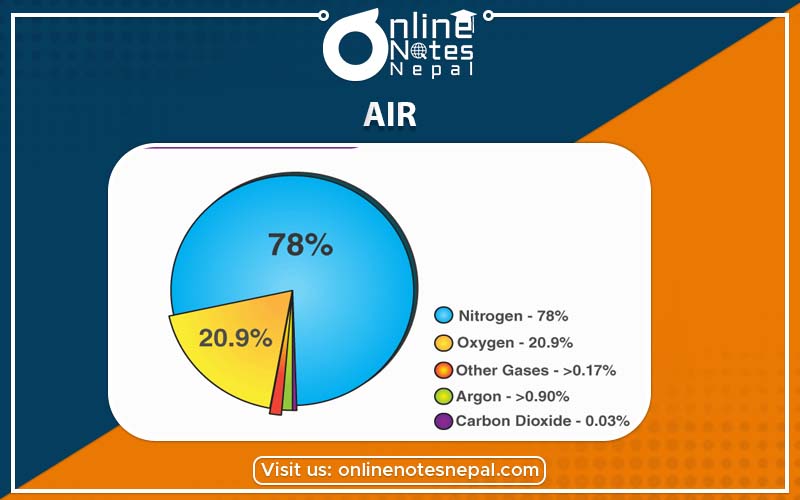Published by: BhumiRaj Timalsina
Published date: 01 Feb 2022

The earth is surrounded with air. The layers of air is known as atmosphere. Air is essential for every living being on the earth. We cannot live without air. Our surrounding is covered with air. We cannot see air. We cannot smell it. It occupies space. It also has weight. It is found everywhere on earth. Every empty object is full of air.
Air is the composition of different gasses. Air used to be known as an element. In 1775 AD, a scientist from France, named Lavoisier proved that the air is the combination of mixture of different gases. Nitrogen is found more than the other gases. It occupies almost 4/5 part of the air. Air contains nitrogen, oxygen, carbondioxide and other gases and as well as water vapour. It also contains dust. The composition of air is almost same in most of the parts of atmosphere. But the water vapour and the dust in the atmosphere depends upon the place and the surrounding.
The formation of the air according to the volume is listed below:
Gas Volume
Nitrogen 78%
Oxygen 21%
Carbondioxide 0.03%
Inert gas 0.95% Water vapour depends on the surroundings
Other gases 0.02%
1. Air is the combination of different gases.
2. Air has weight.
3. Air occupies spaces.
4. Air is colorless, tasteless, and odourless.
5. The oxygen present in the air causes the rusting.
6. Due to the presence of oxygen, things can burn in air.
7. Air can move from one place to another.
8. Air can be compressed.
The uses and the introduction of the gases present in air.
Air is the combination of different gases. Nitrogen, oxygen, and carbon dioxide are the main gases present in the air. These gases have their own uses.
Nitrogen occupies most of the space in the air. Its volume is approximately 78%. Usually, it does not show any combination with different substances. It cannot be directly used by plants and animals. But it has its own importance, they are:
1. It helps to make chlorophyll in the plants. Without the presence of chlorophyll, the plants turn yellow in colour.
2. It helps in the growth and the development of a plant.
3. Every animal directly or indirectly uses it in the manufacture of protein.
4. It is kept inside an electric bulb.
The second most abundant gas in the atmosphere is oxygen. Its volume is approximately 21%. It is an active gas. It can easily react with other substances.
Importance of oxygen are:
1. It helps to burn substances.
2. It is essential for breathing.
3. The patients in the hospital are provided with oxygen.
Carbon dioxide is found approximately 0.03% in the air. It is very much essential for the plants. But animals cannot directly use it.
Its importance are:
1. For the process of photosynthesis, plants use carbon dioxide. All the animals in the world eat plants as a source of food.
2. It is used to extinguish fire.
3. It is used in manufacture of soda water, beer, coke etc.
The presence of the water vapour in the air depends upon its surroundings. Due to the evaporation in the substance, there is water vapour in the air. The amount of water vapour in the air is called humidity. The water vapour present in the air is important for all living beings.
Its importance are:
1. It helps to protect the leaves of the plants from being dry.
2. It helps to keep the vegetables and fruits fresh and juicy.
3. It helps to protect the animal skin from being dry.
The uses and the introduction of the gases present in air.
Air is the combination of different gases. Nitrogen, oxygen, and carbon dioxide are the main gases present in the air. These gases have their own uses.
Nitrogen occupies most of the space in the air. Its volume is approximately 78%. Usually, it does not show any combination with different substances. It cannot be directly used by plants and animals. But it has its own importance, they are:
1. It helps to make chlorophyll in the plants. Without the presence of chlorophyll, the plants turn yellow in colour.
2. It helps in the growth and the development of a plant.
3. Every animal directly or indirectly uses it in the manufacture of protein.
4. It is kept inside an electric bulb.
The second most abundant gas in the atmosphere is oxygen. Its volume is approximately 21%. It is an active gas. It can easily react with other substances. Importance of oxygen are:
1. It helps to burn substances.
2. It is essential for breathing.
3. The patients in the hospital are provided with oxygen.
Carbon dioxide is found approximately 0.03% in the air. It is very much essential for the plants. But animals cannot directly use it.
Its importance are:
1. For the process of photosynthesis, plants use carbon dioxide. All the animals in the world eat plants as a source of food.
2. It is used to extinguish fire.
3. It is used in manufacture of soda water, beer, coke etc.
The presence of the water vapour in the air depends upon its surroundings. Due to the evaporation in the substance, there is water vapour in the air. The amount of water vapour in the air is called humidity. The water vapour present in the air is important for all living beings. Its importance are:
1. It helps to protect the leaves of the plants from being dry.
2. It helps to keep the vegetables and fruits fresh and juicy.
3. It helps to protect the animal skin from being dry.